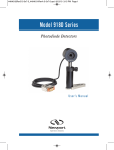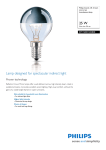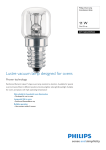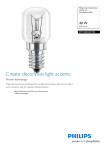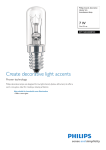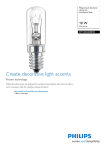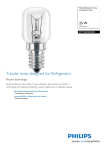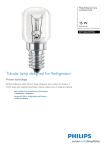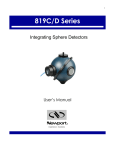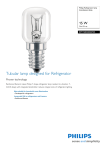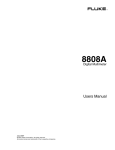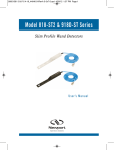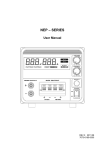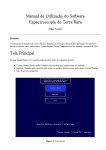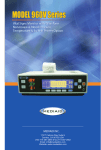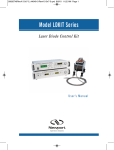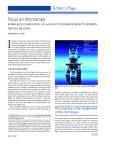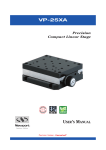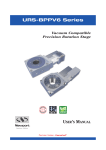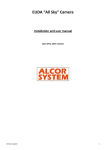Download RevB 818 Series Manual
Transcript
818 Series Photodetector Guide User’s Manual 818 Series Photodetector Guide i ii Warranty Newport Corporation warrants that this product will be free from defects in material and workmanship and will comply with Newport’s published specifications at the time of sale for a period of one year from date of shipment. If found to be defective during the warranty period, the product will either be repaired or replaced at Newport’s option. To exercise this warranty, write or call your local Newport office or representative, or contact Newport headquarters in Irvine, California. You will be given prompt assistance and return instructions. Send the product, freight prepaid, to the indicated service facility. Repairs will be made and the instrument returned freight prepaid. Repaired products are warranted for the remainder of the original warranty period or 90 days, whichever is longer. Limitation of Warranty The above warranties do not apply to products which have been repaired or modified without Newport’s written approval, or products subjected to unusual physical, thermal or electrical stress, improper installation, misuse, abuse, accident or negligence in use, storage, transportation or handling. This warranty also does not apply to fuses, batteries, or damage from battery leakage. THIS WARRANTY IS IN LIEU OF ALL OTHER WARRANTIES, EXPRESSED OR IMPLIED, INCLUDING ANY IMPLIED WARRANTY OF MERCHANTABILITY OR FITNESS FOR A PARTICULAR USE. NEWPORT CORPORATION SHALL NOT BE LIABLE FOR ANY INDIRECT, SPECIAL, OR CONSEQUENTIAL DAMAGES RESULTING FROM THE PURCHASE OR USE OF ITS PRODUCTS. First printing 1999 © 2012 by Newport Corporation, Irvine, CA. All rights reserved. No part of this manual may be reproduced or copied without the prior written approval of Newport Corporation. This manual has been provided for information only and product specifications are subject to change without notice. Any change will be reflected in future printings. Newport Corporation 1791 Deere Avenue Irvine, CA, 92606 USA P/N 90043374 Rev. B iii Confidentiality & Proprietary Rights Reservation of Title: The Newport programs and all materials furnished or produced in connection with them (“Related Materials”) contain trade secrets of Newport and are for use only in the manner expressly permitted. Newport claims and reserves all rights and benefits afforded under law in the Programs provided by Newport Corporation. Newport shall retain full ownership of Intellectual Property Rights in and to all development, process, align or assembly technologies developed and other derivative work that may be developed by Newport. Customer shall not challenge, or cause any third party to challenge the rights of Newport. Preservation of Secrecy and Confidentiality and Restrictions to Access: Customer shall protect the Newport Programs and Related Materials as trade secrets of Newport, and shall devote its best efforts to ensure that all its personnel protect the Newport Programs as trade secrets of Newport Corporation. Customer shall not at any time disclose Newport’s trade secrets to any other person, firm, organization, or employee that does not need (consistent with Customer’s right of use hereunder) to obtain access to the Newport Programs and Related Materials. These restrictions shall not apply to information (1) generally known to the public or obtainable from public sources; (2) readily apparent from the keyboard operations, visual display, or output reports of the Programs; 3) previously in the possession of Customer or subsequently developed or acquired without reliance on the Newport Programs; or (4) approved by Newport for release without restriction. Service Information This section contains information regarding factory service for the source. The user should not attempt any maintenance or service of the system or optional equipment beyond the procedures outlined in this manual. Any problem that cannot be resolved should be referred to Newport Corporation. iv Technical Support Contacts North America & Asia Newport Corporation Service Dept. 1791 Deere Ave. Irvine, CA 92606 Telephone: (800) 222-6440 Asia Lot J3-8, Wuxi Export Processing Zone Jiangsu Province, P.R.,214028 China Tel: +86 510 8113 299 Fax: +86 510 8526 9050 Europe Newport/MICRO-CONTROLE S.A. Zone Industrielle Beaune la Rolande, FRANCE Telephone: (33) 02 38 40 51 56 Newport Corporation Calling Procedure If there are any defects in material or workmanship or a failure to meet specifications, promptly notify Newport’s Returns Department by calling 1-800-222-6440 or by visiting our website at www.newport.com/returns within the warranty period to obtain a Return Material Authorization Number (RMA#). Return the product to Newport Corporation, freight prepaid, clearly marked with the RMA# and we will either repair or replace it at our discretion. Newport is not responsible for damage occurring in transit and is not obligated to accept products returned without an RMA#. E-mail: [email protected] When calling Newport Corporation, please provide the customer care representative with the following information: • Your Contact Information • Serial number or original order number • Description of problem (i.e., hardware or software) To help our Technical Support Representatives diagnose your problem, please note the following conditions: • Is the system used for manufacturing or research and development? • What was the state of the system right before the problem? • Have you seen this problem before? If so, how often? • Can the system continue to operate with this problem? Or is the system non-operational? • Can you identify anything that was different before this problem occurred? v vi Table of Contents Warranty..........................................................................................................................................................iii Technical Support Contacts.............................................................................................................................v Table of Contents.............................................................................................................................................1 Section 1 — General Information 1.1 Unpacking and Inspection.......................................................................................................................2 1.2 Calibration Services.................................................................................................................................2 1.3 Use with a Newport Power Meter...........................................................................................................2 1.4 Cleanliness...............................................................................................................................................2 1.5 Temperature and Humidity......................................................................................................................2 1.6 Specifications Table.................................................................................................................................3 Section 2 — Calibration Accuracy and Limitations 2.1 Spectral Response....................................................................................................................................5 2.2 Calibration Accuracy and Service...........................................................................................................5 2.3 Uniformity...............................................................................................................................................5 2.4 Saturation.................................................................................................................................................5 2.5 Saturation with Pulsed Power Measurements.........................................................................................6 2.6 Reflections...............................................................................................................................................6 2.7 Photodiode Operation..............................................................................................................................6 2.8 Low Power Measurement Considerations...............................................................................................7 2.9 Noise Characteristics...............................................................................................................................7 2.10 Temperature and Ambient Lighting.........................................................................................................7 2.11 Using the Detector for Non-CW Measurements.....................................................................................8 Section 3 — Service Form 3.0 Service Form............................................................................................................................................9 1 Section 1 General Information This guide contains information necessary for using Model 818 Series photodetectors. A separate data sheet is provided with each detector. All detectors are also provided with individual calibration data. Please read through the guide before attempting to make optical power measurements. CAUTION Applied voltage exceeding the detector specification, forward bias, or optical power exceeding the damage threshold can damage the detector. 1.1 Unpacking and Inspection The items included with every order are given on the data sheet. Please check to be sure that all items are present and are received in good condition. The models with a suffix /CM ship with a 9 pin DIN calibration module. The models with a suffix /DB ship with a DB15 connector that houses the PROM. 1.2 Calibration Services 1.3 Use with a Newport Power Meter 1.4 Cleanliness Newport’s calibration services calibrate (or recalibrate) photodetectors. These services provide the calibration data in a written calibration record and in a programmable read only memory (PROM) for use with a Newport power meter. The photodetector consists of a photodiode attached to a cable terminated with a standard BNC connector and packaged within a protective housing. Some housings provide a place for attaching accessories such as attenuators. Care should be taken not to touch the photodiode window with bare fingers. Contaminants may cause inaccurate measurements, particularly at ultraviolet wavelengths where absorption is common. Lightly clean the detector window with reagent grade alcohol and a soft cotton cloth. Potentially large measurement errors can be generated through scratches, digs and coating damage on detector optical surfaces. The magnitude of an error typically varies directly with the ratio of the intercepted area of the “scratch” relative to the area of the optical beam. NOTE Kleenex and chem-wipes contain wood and fiber glass (respectively) and will scratch optical surface. 1.5 Temperature and Humidity The photodiode sensitivity increases with temperature for wavelengths longer than the peak response wavelength. Best results will be obtained by keeping the detector near the calibration temperature of 25°C. The temperature range 0 – +50°C should not be exceeded and the detector should not be exposed to humidity levels greater than 70% or possible damage to the photodiode could occur. NOTE Refer to Newport web site for the most up to date detector specifications. 2 1.6 Photodetector Specifications Model 818-UV 818-SL 818-IR 818-IG Spectral Range (nm) 200 to 1100 400 to 1100 780 to 1800 800 to 1650 Power Density, Average Max w/ Attenuator (W/cm2)(1) 0.2 2 2 2 Power Density, Average Maximum w/o Attenuator (mW/cm2)(1) 0.2 2 3 3 Pulse Energy, Maximum - w/ Attenuator (µJ/cm2)(2) 0.1 1 0.35 0.35 Pulse Energy, Maximum - w/o Attenuator (nJ/cm2)(2) 0.1 1 0.35 0.35 1% @ 400-940nm, 4% @ 9411100nm 2% @ 780-910nm, 2% @ 9111700nm, 4% @ 1701-1800nm 2% @ 800-900nm, 2% @ 9011650nm 1% @ 400-940nm, 4% @ 9411100nm 5% @ 780-910nm, 2% @ 9111700nm, 4% @ 1701-1800nm 5% @ 800-900nm, 2% @ 9011650nm ±2 ±0.5 ≤2 ≥10 ±2 ±0.5 ≤2 ≥35 (kΩ) ±2 ±0.5 ≤2 ≥20 Uniformity (%)(3) Linearity (%) Rise Time (µs) Shunt Resistance (MΩ) (typ) 4% @ 200-219nm, 2% @ 220-349nm, 1% @ 350-949nm, 4% @ 9501100nm 8% @ 200-219nm, 2% @ 220-349nm, 1% @ 350-949nm, 4% @ 9501100nm ±2 ±0.5 ≤5.9 ≥10 Reverse Bias, Maximum (V) 5 3 0.25 2 NEP (pW/√Hz) 0.45 0.2 0.6 0.04 Silicon Germanium 1 1.13 Cylinder 0.071 0.3 Cylinder Indium Gallium Arsenide 0.071 0.3 Cylinder Calibration Uncertainty (Without Attenuator)(4) Calibration Uncertainty (With Attenuator)(4) Active Area (cm2) Active Diameter (cm) Shape Silicon-UV Enhanced 1 1.13 Cylinder Attenuator, OD3 Detachable Detachable Detachable Detachable Operating Temperature 5°C to 50°C, <70% RH 5°C to 50°C, <70% RH 5°C to 50°C, <70% RH 5°C to 50°C, <70% RH Material 1) Applies to entire spectral response 2) 15 ns pulse width 3) Uniformity specification applies to detector only 4) Calibration uncertainty can be varied depending on the NIST transfer standard uncertainty variation. 3 Model 818-ST(2)-UV 818-ST(2) Spectral Range (nm) 200 to 1100 400 to 1100 0.2 2 0.2 2 0.1 1 0.1 1 Calibration Uncertainty 4% @ 200-219 nm 2% @ 220-349 nm 1% @ 350-949 nm 4% @ 950-1100 nm 1% @ 400-940 nm 4% @ 941-1100 nm Calibration Uncertainty w/Attenuator 8% @ 200-219 nm 2% @ 220-349 nm 1% @ 350-949 nm 4% @ 950-1100 nm 1% @ 400-940 nm 4% @ 941-1100 nm Uniformity (%)(1) ±2 ±2 Linearity (%) ±0.5 ±0.5 Rise Time (µs) ≤3 ≤3 Shunt Resistance (MΩ) (typ) ≥200 ≥200 Reverse Bias, Maximum (V) 5 5 NEP (pW/√Hz) 0.018 0.015 Material Silicon (UV Enhanced) Silicon Active Area (cm2) 1 1 Shape Wand Wand Attenuator, OD3 Built-In Built-In Power Density, Average Max w/ Attenuator (W/cm2) Power Density, Average Maximum w/o Attenuator (mW/cm2) Pulse Energy, Maximum w/ Attenuator (µJ/cm2) Pulse Energy, Maximum w/o Attenuator (nJ/cm2) 1) When measured with beam centered and filling 80% of active area. 4 Section 2 Calibration Accuracy and Limitations 2.1 2.2 Spectral Response Calibration Accuracy and Service The response of the detector depends on the wavelength of the incident light. The photodiode is transparent for photon energies less than the band gap which determines the long wavelength infrared sensitivity limit. The short wavelength limit is determined by the photodiode manufacturing process and possibly, in the case of silicon photodiodes, by strong window absorption. The photodiode response is commonly measured in amps of photocurrent per watt of incident optical power. Typical response curves for the photodetector is shown on the data sheet. The transmission of the attenuator (if provided) may vary considerably across the detector’s range. Statement of Calibration The accuracy and calibration of this photodetector are traceable to the NIST or NPL through equipment which is calibrated at planned intervals by comparison to certified standards maintained at Newport Corporation. Newport Corporation calibrates its detectors using secondary standards directly traceable to the United States National Institute of Standards and Technology or National Physical Laboratory. At wavelengths where appropriate standards are not available, Newport calibrates its detectors by comparison to detectors calibrated with thermal detectors. The absolute accuracy of the photodetector calibration is indicated in the calibration certificate. Individual detector response can change with time at different wavelengths, especially in the ultraviolet, and should be returned for recalibration at 1 year intervals to assure confidence in the accuracy of the measurement. For recalibration services, see the Accessories and Services information. 2.3 2.4 Uniformity Fabrication processes may cause the response of the detector to vary slightly over the detector surface. Calibration involves illumination of approximately 70% of the detector central active diameter. Optical signals being measured should illuminate the same area. Care should be taken not to overfill the detector if accuracy is to be maintained. Saturation For low optical power, the photocurrent is proportional to the optical signal incident on the photodiode and the photocurrent linearly increases with optical power. For high optical powers saturation of the detector begins to occur and the response signal is no longer linearly proportional to the incident power. Optical power measurements must be made in the linear region to be valid. NOTE The saturation is “soft”, i.e. the detector output does not suddenly stop increasing, but the rate of increase slows. For Gaussian and other signals with spatially varying intensities, local saturation may occur. The onset of saturation is not always obvious and is a common source of inaccurate measurements. 5 To determine if the detector is saturating, follow the steps below: 1. Measure the photodetector current (or power), and record this value (A). 2. Place a filter or attenuator of known transmission (T) in the beam path. Record the current again (B). A filter transmission of 0.001 is a convenient choice. 3. The power with the filter in place should be the product of the power measured without the filter and the transmission of the filter, i.e. B = A x T. The transmission (T) of the filter can be determined by following the steps below: 1. Reduce the optical power to a level low enough to avoid saturation, but high enough that, when it is reduced by the filter it can still be accurately measured. 2. Follow steps 1 and 2 in the procedure above. 3. Calculate the ratio T = B/A to determine the transmission of the filter at the wavelength of light used for the measurement. The calibrated filter (or attenuator) can be used with the detector to measure the power of higher power beams. 2.5 2.6 2.7 Saturation with Pulsed Power Measurements Saturation effects when using pulsed lasers are a complex phenomenon, and depends upon the wavelength, peak power, pulse shape, average power, repetition rate, and on the detection circuit. However, the test for saturation described immediately above should be used whenever pulsed power measurements are being made. Alternatively, when the detector is used for observing pulse shape, placing an attenuator in the beam should affect only the pulse amplitude, not the pulse shape. Reflections The photodetector surface, window material and the attenuator all reflect light. The amount of reflected light depends upon the angle of incidence and the polarization of the beam. Reflected light does not get absorbed by the detector, and therefore is not included in the detector signal. The Newport detector and attenuator calibration include the loss due to reflection for incoherent light incident normal to the detector. For accurate power measurements the detector should therefore be used at near normal incidence. Photodiode Operation When a photon is absorbed in the photodiode, an electron-hole pair is formed within the device and a voltage is developed across the diode junction. If the photodiode terminals are connected a photocurrent proportional to the light intensity will be generated. Measuring this photocurrent provides a measurement of the optical power incident upon the detector. Figures 3(a) and 3(b) show common methods of measuring the photocurrent generated by the photodiode. In circuit (a) a bias voltage is used to drive the current through a load resistor and the voltage drop is measured. This is called the photoconductive mode of operation. The bias voltage enhances the speed of response and the linearity of the photocurrent generation but introduces additional noise and dark current. Circuit (b) shows the use of a Op-amp to enable unbiased photocurrent measurement. Operation with zero bias is called the photovoltaic mode because the photodiode is actually generating the bias voltage. This is the method used in Newport Power Meters. The feedback resistance in circuit (b) is selectable. 6 RFEEDBACK LIGHT I VOUT I − RLOAD + + VOUT LIGHT VBIAS (a) Reverse Bias Circuit Photoconductive Mode — improved time response and linearity (b) Op-Amp Circuit Photovoltaic Mode — reduced noise Figure 3 — Photodiode Operational Circuits 2.8 2.9 Low Power Measurement Considerations Measurements of very low power optical sources are possible with the photodetector. To use the detector properly and achieve accurate results requires the understanding of a number of effects that limit the device performance, which are discussed in paragraphs 2.9 and 2.10. Noise Characteristics The lower limits of optical detection are determined by the noise characteristics of the detector and/or amplifier. Theory predicts that the photodiode noise is largely thermal (Johnson) noise associated with the effective resistance of the photodiode and shot noise from dark current. The dark current at 10 mV bias voltage is measured and used to define the effective resistance of the diode, the shunt resistance, given in the data sheet: Rshunt = Vbias (10 mV) / Idark. Ideally an input amplifier connected as in Figure 3 (b) would have no offset voltage and there would be no dark current. In practice though, a small bias usually exists, and even at zero applied bias a small dark current is present. The maximum dark currents when used with Newport power meters are given in the specifications. The drift in this dark current is generally much smaller than the dark current so effective cancellation is often possible. For non-DC measurements the light detection limit is more generally expressed as the intensity of light required to produce a current equal to the noise current. This is called the noise equivalent power (NEP) and has units of optical power divided by the square root of the detector bandwidth: W /√Hz. The NEP varies inversely with the spectral response of the photodiode and depends on the wavelength, λ, the noise frequency, f, and bandwidth, Δf. NEP is therefore defined as NEP( λ, f, Δf ). Lock-In amplifier techniques can be used to approach the NEP. Temperature and 2.10 Ambient Lighting Drifts in temperature and ambient lighting can cause significant variations in diode response and amplifier performance for low power measurements, particularly for wavelengths longer than the bandgap. It is therefore important to provide as constant environmental conditions as practical, including consideration of air conditioning and roomlighting effects. In addition the noise and dark current generally increase exponentially with detector temperature so it is best to keep the temperature close to 25°C. Some 818 Series photodetectors (e.g. Models 818-SL, -UV, -IR, -IG) have threads for the attachment of accessories. With these models, the effects of 7 ambient lighting can be minimized by using the Model 818-FA Fiber Adapter Holder with the appropriate FP3 or FP4 series fiber adapter when measurements of power in fiber optics are being made. If free space beam measurements are desired, using an attenuator will reduce stray light and often improve the ratio of signal to background. Wavelength specific filters, such as optical cutoff, bandpass, or spike filters can also be used if the signal wavelength spectrum permits. Other techniques to reduce stray light include using apertures to admit only the laser beam, placing the detector in a box to shield the surface and turning off the room and other lights. Using the Detector 2.11 for Non-CW measurements When the photodetector is used with a Newport Power Meter it is operated essentially without bias voltage, as depicted in Figure 3 (b). The effective time constant of the detector-amplifier combination may be much slower than the characteristic time of the signal. Nonetheless, if the detector-amplifier combination does not become saturated, effective integration of the signal will occur, and accurate energy measurements of very short pulses can be made. It is also possible to use the photodiode for the display of the temporal behavior of an optical signal with an oscilloscope. CAUTION Forward biasing the detector can destroy the diode. Reverse bias should not be used in conjunction with the Newport Power Meters and in no circumstances should the bias voltage exceed the breakdown voltage of the photodiode. 8 3.0 Service Form Newport Corporation U.S.A. Office: 800-222-6440 FAX: 949/253-1479 Name_____________________________________ Return Authorization #_______________________ __________________________________________ (Please obtain RA# prior to return of item) Company_________________________________________________________________________________ Address ___________________________________ Date_______________________________________ Country____________________________________ Phone Number_______________________________ P.O. Number________________________________ FAX Number________________________________ Item(s) Being Returned: Model # ___________________________________ Serial #_____________________________________ Description ______________________________________________________________________________ ________________________________________________________________________________________ ________________________________________________________________________________________ ________________________________________________________________________________________ ________________________________________________________________________________________ ________________________________________________________________________________________ Reason for return of goods (please list any specific problems): ________________________________________________________________________________________ ________________________________________________________________________________________ ________________________________________________________________________________________ ________________________________________________________________________________________ ________________________________________________________________________________________ ________________________________________________________________________________________ ________________________________________________________________________________________ ________________________________________________________________________________________ ________________________________________________________________________________________ ________________________________________________________________________________________ ________________________________________________________________________________________ 9

















